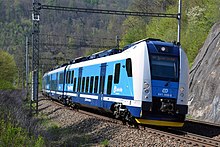
Back Адәыӷба Abkhazian Trein Afrikaans Zug (Eisenbahn) ALS ባቡር Amharic Tren AN Trǣg ANG Teren ANN रेलगाड़ी ANP قطار Arabic تران ARY
| Train | |
|---|---|
 Passenger train powered by overhead electricity in the Czech Republic |

A rail train, otherwise referred to as simply a train, is a set of railway[a] cars (also called vehicles) that are tied together with or without a locomotive.[b][1] Trains are used to carry people, and also things like raw material, finished goods, cargo, and waste. The vehicles that carry freight are called cars (in the United States) or wagons (in the United Kingdom). The ones that carry passengers are often called coaches or carriages. A place where a train stops to let people get on and off is called a train station or railway station.
Trains have their roots in wagonways, which used railway tracks and were powered by horses or pulled by cables. Following the invention of the steam locomotive in the United Kingdom in 1804, trains rapidly spread around the world, allowing freight and passengers to move over land faster and cheaper than ever possible before. Rapid transit and trams were first built in the late 19th century to transport large numbers of people in and around cities. Beginning in the 1920s, and accelerating following World War II, diesel and electric locomotives replaced steam as the means of motive power. Following the development of cars, trucks, and extensive networks of highways which offered greater mobility, as well as faster airplanes, trains declined in importance and market share, and many rail lines were abandoned. The spread of buses led to the closure of many rapid transit and tram systems during this time as well.
Cite error: There are <ref group=lower-alpha> tags or {{efn}} templates on this page, but the references will not show without a {{reflist|group=lower-alpha}} template or {{notelist}} template (see the help page).
- ↑ "Definition of train (1a)". www.merriam-webster.com. Retrieved 27 October 2022.
a connected line of railroad cars with or without a locomotive